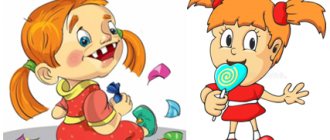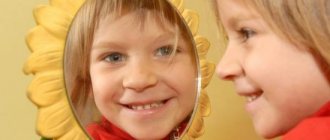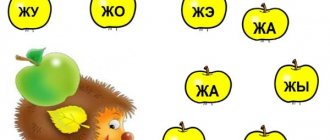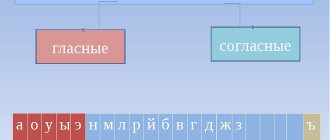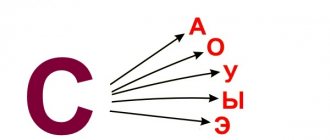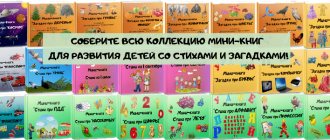Differentiation of sounds K-T presentation on speech therapy
Slide 1
Sounds K-T Presentation for classes on differentiating sounds K-T Prepared by teacher-speech therapist GKUZ Orphanage Tyumen Bokova E.Yu.
Slide 2
The purpose of this speech therapy lesson is the differentiation of sounds K-T. Tasks solved during a speech therapy lesson: Correctional and educational: Form differentiation of sounds based on various analyzers: speech-auditory, speech-motor, visual. Correctional and developmental: Develop phonemic awareness. Develop the skill of sound-syllable analysis of words. Correctional and educational: Develop self-control skills. Preliminary work: staging and automation of sound staging and automation of sound
Slide 3
Hammer and Rain t-t-t k-k-k
Slide 4
What do the letters that represent sounds look like?
Slide 5
Game "Hammer-Rain". Instructions: “When I say (show) “rain”, you pronounce the sound K, when I say (show) “hammer”, you pronounce the sound T.”
Slide 6
Game "Slam-stomp". Instructions: “If you hear the syllable TA (a word with the sound “t”) - clap, if you hear the syllable KA (a word with the sound “k”) - stomp” ka - ta - kata - ta - ta - kata - ta - kata ta - ta - kata - ta - ta - kata - ta - ta - kata - ta -ta - kata - ta - ta - ta - taka - ta - ka- ka there, cube, basin, Tom, horse, Tolya, cinema, lotto, piece, this, salad, fireplace, robe, here, boar, plane, cuckoo, pilot, here, fireworks, com, sleeping, castle, sleeping, drinking , tongue, runs, bull, cries, poppy, sits, tank, eats, sings, like, being driven, no, godfather, screw, fog, side, rooster.
Slide 7
Game "Palm-fist". The child shows his palm if he hears a syllable with the sound T, clenches his palm into a fist if he hears a syllable with the sound K.
Slide 8
The tongue on the teeth hid deep t-t-t k-k-k
Slide 9
And the game “Show where the tongue is in the words” (the child points to the teeth or throat when pronouncing words) Piece, basin, there, like, wild boar, Tanya, Tolya, Kolya, kiwi, Tom, here, Cossack, Tima, notes, tongue , table, chair, horses, fireworks, piece, light, ticket, leaf, goats, writes, godfather, flies, flight, cabin, pilot, carpet, plane, sews, carries, lucky, sits, makes, lies, fireplace, zucchini
Slide 10
K and T in one word cabinet, rope, captain, hood, roll, skating, caftan, fleece, branch, baby, duck, cat, current, comet, room, candy, hoof, jacket, hammer, skein, hunter, knock, knock, traveler, skating rink, candy, pumpkin, whistle, scarf.
Slide 11
Tolya and Kolya
Slide 12
Tolya and Kolya go to visit (ta-yellow, ka-red)
Slide 13
Tolya and Kolya (help me separate the pictures, Wheel - with the sound k, Tolya - with the sound t) cubes cake basin wheel seal book
Slide 14
K and T in one word CAT KIT CABIN ROLLER TABLETS TAXI BUSH SCOOTER THIN ROLLING
Slide 15
K-t in phrases Wild duck Thin thread
Slide 16
In the text - Knock! Tuk! Knock! -Who is this? - It’s me, the cat, the thin claw!
Sound automation stage.
Automation of sounds is carried out consistently, through repeated training. Sound automation procedure:
- Isolated utterance;
- In syllables:
- in straight syllables (consonant + vowel);
- in reverse syllables (vowel + consonant);
- between vowels (vowel + consonant + vowel);
- in conjunction with a consonant sound (consonant + consonant + vowel);
- In words;
- In phrases;
- In sentences;
- In the text;
- In tongue twisters, pure tongue twisters, in your own speech.
Video: sound automation L
Sound production stage.
The goal of this stage is to develop the initial skills of correctly pronouncing a sound and is achieved in two ways:
- By imitation;
- With mechanical assistance.
The production of sound with mechanical assistance depends on the characteristics of its articulation. Probes, spatulas, and probe substitutes can be used as mechanical assistance.
Video: setting the sound p
Important to remember! The production of sounds should be carried out by a speech therapist exclusively in the conditions of individual work with the child.
Speech therapy work to eliminate deficiencies in the pronunciation of sounds k, g, x.
Preparation period
Preparatory work is aimed at working out:
- articulatory praxis:
lip position for all vowel sounds
development of mobility of the back of the tongue, its rise to the palate. Exercises: swallowing, yawning - when performing - visual and tactile control. If necessary, we restore the swallowing function: voluntary swallowing of a drop of water or syrup, mechanical assistance (exclude the participation of the lips and the front part of the back of the tongue)
Technique for setting the sound K
- from articulatory gymnastics: exercises “Slide”, “Pussy is angry”, etc.
- by imitation with demonstration of articulation using hand plastics
- mixed method:
with mechanical assistance from the supporting syllable TA. While pronouncing the syllable TA, press on the front edge of the tongue and hold it behind the lower incisors and then slowly move it back
TA-TYA – KYA – KA
The duration of the production varies.
In the future - pronunciation without mechanical assistance (you can use the following technique: use a finger to your mouth - the tongue reflexively moves back)
Technique for setting the sound G
- by imitation
- from the reference sound K by analogy with vowels
- mixed method:
from the supporting syllable YES with mechanical assistance. Sequence as with the sound K
YES – YA – GYA – GA
Technique for setting the sound X
- by imitation - “let’s warm our hands”
- from the reference sound K - accompaniment of articulation with aspiration kx
- mixed method: from the supporting syllable SA with mechanical assistance
SA – SYA – HYA – HA
Didactic game for children 5-7 years old. Differentiation of sounds G-D
Didactic game for older preschoolers: “Picture row - G//D”
Author: Lyanguzova Olga Zhanovna Position: teacher - speech therapist Place of work: MKDOU No. 18, Miass, Chelyabinsk region Description: didactic game for differentiating sounds G//D Purpose material: game for children 5 – 7 years old. Equipment: 1 – segment, 12 – pictures (2 options for each) Purpose: differentiation of G//D sounds, development of mental processes. Objectives: 1. Differentiate the sounds G//D in words and sentences. 2. Develop visual attention and memory. 3. Develop self-control when performing exercises. Method of work: Vocabulary: rainbow, arc, nest, nails, carnation, Goodwin, thermometer, road, fortune teller, black ice, horn, brigade. Picture material:
Line segment:
“Find the correct order” The adult fills part of the segment (up to the blue line) with pictures. The child is asked to look at and name the pictures that are located on the left half of the segment. After which he needs to choose from the proposed pictures the same ones as on the segment and place them on the right half, maintaining the sequence. If the child has distracted attention, it is necessary to offer him the same pictures as in the segment (exclude unnecessary pictures). Simultaneously with laying out the pictures, the child verbalizes what he is doing. If a child differentiates sounds at the level of words, he names words; if he pronounces sentences, he pronounces phrases such as: “I lay the road behind the rainbow.” “Work with both hands” In order for both hemispheres of the brain to work harmoniously, exercises for working with both hands are often recommended. Since it is very difficult to start writing or drawing with both hands at the same time, we will start with a simpler exercise - laying out pictures. At the same time, we invite the child to choose two identical ones from the proposed pictures and lay them out on a segment. Both hands can lay out: from left to right (right hand from the blue line), from right to left (left hand from the blue line), towards each other (left - left, right - right). Doesn't forget to say what he's doing. The top row of pictures shown is laid out from top to bottom (the most preferred arrangement for boys. “Memory” Since each picture is paired, it is possible to play the game: “Memory”. All cards are shuffled and placed face down. Players take turns opening and turning over 2 cards. If they are the same, he takes it for himself, if not, he turns it over again. The rest need to remember where which card is.
Download Didactic game "Picture Row - G//D"
We recommend watching:
Didactic game for children 5 - 7 years old Speech therapy leisure in the preparatory group Winter tongue twisters and poems for automating and differentiating sounds Didactic game for preschoolers 4-7 years old
Similar articles:
Tongue twisters for practicing the sounds of the Russian language
Correction of dyslalia
Speech therapy work to correct dyslalia consists of the following stages:
- Examination of a child’s sound pronunciation;
- Correction of impaired speech sounds:
- Development of articulatory motor skills;
- Formation of skills in distinguishing speech sounds based on acoustic and articulatory features (work on phonemics);
- Production of disturbed sounds;
- Automation and introduction of formed sounds into speech.
The following stages are distinguished in the work on correcting sound pronunciation:
- Preparatory;
- Sound production;
- Sound automation;
- Sound differentiation.
The purpose of the preparatory stage is to prepare the organs of the articulation apparatus for the pronunciation of sounds: at this stage, the accuracy, strength and differentiation of movements of the articulation organs are worked out; work is underway to develop speech exhalation. At the preparatory stage, the child learns to perform articulatory gymnastics exercises, as well as various breathing exercises.
Important to remember! There is a basic set of exercises for developing the basic movements and position of the organs of the articulatory apparatus. Additional sets of exercises necessary for staging certain groups of sounds are selected for the basic complex.
Important to remember! Exercises to develop speech breathing help children develop targeted exhalation, which is necessary for mastering difficult-to-pronounce sounds.
Instructions for performing articulation gymnastics, as well as a list of exercises, can be read in our article
Video of articulation gymnastics:
Photos and videos of breathing exercises
